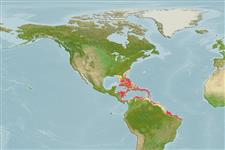Environment: milieu / climate zone / depth range / distribution range
Ecology
Marine; reef-associated; non-migratory; depth range 3 - 92 m (Ref. 9710), usually 3 - 35 m (Ref. 40849). Tropical; 37°N - 29°S, 100°W - 28°W (Ref. 55266)
Western Atlantic: Georgia (USA), Bermuda, and northern Gulf of Mexico to Santa Catarina, Brazil (Ref. 57756).
Length at first maturity / Size / Weight / Age
Maturity: Lm 15.8 range ? - ? cm
Max length : 35.0 cm TL male/unsexed; (Ref. 3797); common length : 30.0 cm TL male/unsexed; (Ref. 3797)
Dorsal spines (total): 14; Dorsal soft rays (total): 17 - 19; Anal spines: 3; Anal soft rays: 18 - 20. Front of body yellow; remaining parts of body, dorsal fin, and front of anal fin black. Caudal fin entirely yellow (Ref. 26938). Front margin of anal fin and edge of gill cover orange; bright blue on upper and lower part of iris. The young of about an inch in length are entirely yellow except for a blue-edged black spot on the upper side of the body posterior to the midpoint; with growth the black spot soon expands to become the large black area covering most of the body and dorsal and anal fins (Ref. 13442).
Inhabits rock jetties, rocky reefs and rich coral areas. Juveniles often associated with fire corals (Ref. 9710). Feeds on tunicates, sponges, zoantharians and algae. Marketed fresh (Ref. 3797).
Life cycle and mating behavior
Maturity | Reproduction | Spawning | Eggs | Fecundity | Larvae
Protogyny has been proposed for this species awaiting confirmation (Ref. 103751).
Allen, G.R., 1985. Butterfly and angelfishes of the world. Vol. 2. 3rd edit. in English. Mergus Publishers, Melle, Germany. (Ref. 4858)
IUCN Red List Status (Ref. 130435: Version 2024-2)
Threat to humans
Reports of ciguatera poisoning (Ref. 30303)
Human uses
Fisheries: minor commercial; aquarium: commercial
Tools
Special reports
Download XML
Internet sources
Estimates based on models
Preferred temperature (Ref.
123201): 25.4 - 28, mean 27.4 °C (based on 220 cells).
Phylogenetic diversity index (Ref.
82804): PD
50 = 0.5078 [Uniqueness, from 0.5 = low to 2.0 = high].
Bayesian length-weight: a=0.03388 (0.01769 - 0.06490), b=2.89 (2.73 - 3.05), in cm total length, based on LWR estimates for this species & (Sub)family-body (Ref.
93245).
Trophic level (Ref.
69278): 3.0 ±0.0 se; based on diet studies.
Resilience (Ref.
120179): Medium, minimum population doubling time 1.4 - 4.4 years (Preliminary K or Fecundity.).
Fishing Vulnerability (Ref.
59153): Low vulnerability (25 of 100).
Nutrients (Ref.
124155): Calcium = 42.5 [21.5, 68.9] mg/100g; Iron = 0.511 [0.313, 0.828] mg/100g; Protein = 18.3 [17.1, 19.5] %; Omega3 = 0.104 [0.067, 0.163] g/100g; Selenium = 37 [21, 69] μg/100g; VitaminA = 65 [18, 234] μg/100g; Zinc = 1.23 [0.86, 1.72] mg/100g (wet weight);
